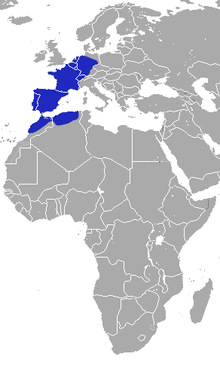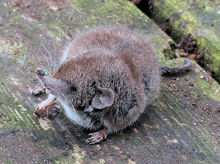Greater white-toothed shrew
| Greater white-toothed shrew[1] | |
|---|---|

| |
| Scientific classification | |
| Domain: | Eukaryota |
| Kingdom: | Animalia |
| Phylum: | Chordata |
| Class: | Mammalia |
| Order: | Eulipotyphla |
| Family: | Soricidae |
| Genus: | Crocidura |
| Species: | C. russula
|
| Binomial name | |
| Crocidura russula (Hermann, 1780)
| |

| |
The greater white-toothed shrew (Crocidura russula) is a small
Physical description

The greater white-toothed shrew is distinguished by a careful examination of its unpigmented teeth. Like other white-toothed shrews, C. russula lacks the deposition of iron in their enamel at the tips of their teeth.[8] This particular species has a greyish or reddish brown upper coat with a yellowish grey coat in the underside.[9] The greater white-toothed shrews are part of the medium-sized shrews and weigh around 11 to 14 grams.[3] The head and body length of C. russula is about 6 to 9 cm and the tail length averages to about 3 to 4.3 cm.[3]
Habitat
C. russula are found in temperate regions with plentiful insects. They are generally found in habitats such as
Diet
The greater white toothed shrew is a carnivore, feeding mainly on invertebrates and occasionally small rodents, lizards and small amphibians.[3]
Predation
The greater white-toothed shrew is preyed upon by several animals;
Behavior
The greater white-toothed shrews are classified as semi-social mammals. During winter, C. russula are found sharing nests and enter torpor.
Reproduction
The greater white-toothed shrew typically experiences one breeding season in its entire lifetime, whereby
Life span
C. russula has a lifespan of about 18 months in the wild, but can survive for 30 months in captivity under laboratory conditions.[13]
Role in the ecosystem
C. russula serves as a prey species to many animals, however, an abundance in this species may lead to a decline in other small mammals such as pygmy shrews. In April 2008, the greater white-toothed shrew was discovered in
References
- OCLC 62265494.
- . Retrieved 23 April 2021.
- ^ S2CID 198155850.
- ^ David R Stone (1995). "Eurasian Insectivores and Tree Shrews- Status Survey and Conservation Action Plan". Archived from the original on 2014-12-26. Retrieved 2011-11-28.
- ^ Molina, O. et al. (2003) "The origin of the Osorian shrew (Crocidura osorio) from Gran Canaria resolved using mtDNA". Italian Journal of Zoology, Volume 70, Issue 2
- ^ ISBN 84-273-0265-7.
- ISBN 978-0-8018-5789-8.)
{{cite book}}: CS1 maint: multiple names: authors list (link - ISBN 978-0852639511.
- ^ Morris, P. A red data book for the British Mammals. The Mammal Society, London.
- ^ PMID 28565220.
- S2CID 54320480.
- ^ PMID 19535367.
- PMID 19526053.
- ^ a b "For Good Or Ill, Ireland Gains Another Mammal Species". Science Daily. 2008-04-28. Retrieved 2008-05-07.
- PMID 24955824.

